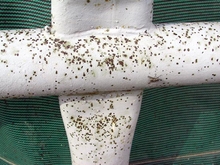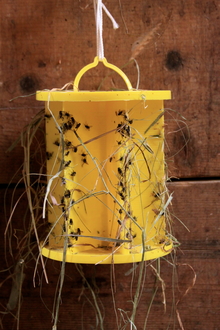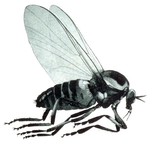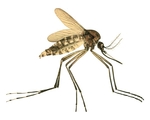Quick facts
- Control filth flies by managing moisture from manure, bedding, feed and mud.
- Traps, stingless parasitic wasps and insecticides for filth flies are most effective when combined with debris management.
- Managing water sources and providing your horse with deep shade or housing can best protect them from aquatic biting flies.
- Work with a veterinarian to have your horse vaccinated for mosquito-transmitted viruses.
Flies are a natural part of keeping horses. Filth flies and aquatic biting flies are the main concerns in Minnesota.
Understanding these pests and how they live and breed can help horse owners limit their fly pest problems.
How do flies affect horses?
- Transmit viruses and diseases.
- Cause welts or skin irritation at bite sites.
- Cause hoof damage from excessive stomping.
- Cause overall discomfort as horses try to avoid them.
Horses usually swish their tails or stomp their feet to get flies to leave. They may also try to move their heads toward their bodies and limbs or twitch their skin to get rid of them.
How to best manage flies
- Keep your facilities clean and dry.
- Remove manure and soiled bedding from horse areas often.
- Use fly protectant products such as citronella spray, leg bands or leggings on your horses.
- Provide a physical barrier between your horse and flies.
- Use nets and screens on your barn doors and windows.
- Use fly sheets and masks on your horses.
- Use residual premise sprays where flies perch (barn walls and ceilings).
Filth flies
Filth flies develop in moist organic debris such as:
- Aging feces
- Soiled animal bedding
- Rotting feed debris
Stable flies
Stable fly adults have seven black spots on a gray abdomen. Their heads have bayonette-like mouth parts that pierce the skin for blood.
Biting stable flies cause horses and other livestock to swish their tails, twitch their flanks and stamp their feet. Only 5 percent of adult stable flies near a horse will be on the animal at any one time. The other 95 percent will perch on nearby fencing, buildings, and plants.
House flies
House flies don’t bite animals, but can spread fecal bacteria. House flies will feed at horses' eyes, body orifices and fresh manure. Like stable flies, only a small fraction of house flies are on a horse at any one time.
Lifecycle of filth flies
In Minnesota, filth flies reproduce continuously from May into October. Adult females lay 50 to 150 eggs every few days. Females place eggs in moist organic debris.
Small maggots hatch from eggs and feed on bacteria growing in the debris. Ideal conditions for maggots are in debris that is 40 to 80 percent moisture and 70 to 95 F.
Mature maggots:
- Are 1/4 to 1/2 inch long.
- Have heads that taper to a point.
- Have round abdomens with two dark pores used for breathing.
Common debris sources around horse barns:
- Muck near leaky waterers.
- Old hay around feeders.
- Piled manure.
- Soiled bedding.
Maggots mature into pupae and then into winged adults (flies). The entire life cycle can take as little as two weeks. Adults can live one to three weeks depending on the weather.
Learn more about filth flies.
Reduce fly-attracting debris
Control filth flies around your barn by managing debris. Scout weekly for possible maggot breeding sites. Preventing debris will be more effective than chemical control.
- Feed: Keep dry. Avoid ground feeding. Disk, spread or compost waste.
- Manure: Clean up at least two times per week. Spread or compost.
- Bedding: Replace weekly. Wood shavings and sawdust produce fewer flies than straw.
- Waterers: Place in well-drained areas and away from where you feed horses. Keep in good repair.
Chemical and non-chemical control
Insecticides
Insecticides are much less effective if you don’t manage debris. You can use pyrethrum or resmethrin fogs and space sprays to kill adult flies indoors. These only provide temporary relief.
You can apply longer-lived pyrethroid and organophosphate residual premise sprays indoors and outdoors. These are most effective if you apply them to fly perching areas. Residual premise sprays may be effective for up to 3 weeks. Longevity depends on the cleanliness of the site you spray.
Stable and house flies perch on solid surfaces where they won’t get disturbed, often above head height. You can identify perching sites by fly specks. Fly specks are small brown spots of fly waste. Identifying perching sites can help you determine where to apply residual insecticides for adult flies.
Always carefully read and precisely follow label instructions when using chemical insecticides.
Provide a physical barrier between your horse and flies
- Use nets and screens on your barn doors and windows.
- Use fly sheets, masks, or fly boots on your horses. Routinely check all horse wear to make sure they have not shifted, rubbed, or caused other issues.
Fly traps
Poor debris management or off-site fly sources can limit the efficacy of fly traps. Sticky traps and ultraviolet electrocution traps will catch and kill stable and house flies. Baited traps will attract and kill house flies, but not stable flies.
Stingless parasitic wasps
Stingless parasitic wasps are small, ant-like insects that kill filth fly pupae.
- They occur naturally around animal premises.
- They provide natural biological control of filth flies.
- They are harmless to people and animals.
Female wasps lay eggs inside fly pupae and the wasp larvae kill the developing fly pupae.
You can purchase and release parasitic wasps to supplement natural populations. Success is inconsistent among studies. It likely depends on the amount of fly breeding media and number of fly pupae they must kill.
Fly repellants
Fly repellants provide temporary relief from stable flies. Effectiveness can provide temporary relief from attacking stable flies. You should apply repellants to the legs, where stable flies are most likely to attack. You will need to reapply it if your horse walks through wet vegetation.
Natural remedies
Bags of water
Hanging plastic bags of water around buildings has no evidence showing it repels house flies.
Homemade repellents
Recipes for stable and other biting fly repellents usually include:
- Water
- Vinegar
- Bath oil
- Mouthwash
- Plant oils: may repel mosquitoes but not as effective as commercial products
- Herbal extracts
Some of the ingredients in these recipes may harm horses with sensitive skin.
Products registered with the Environmental Protection Agency (EPA) have undergone extensive safety testing. These products carry an EPA number on their label.
Barn lime
- Hydrated lime or calcium hydroxide (commonly sold as barn lime) reduces moisture and can reduce ammonia odor in barn stalls. It can increase soil pH if you use it in large amounts.
- The minimal amount of barn lime used in horse facilities isn’t good for fly control. Fly maggots tolerate a wide range of pH.
- Using too much lime in pastures can stop some plant growth.
Recent research evaluated six adult horses for six weeks to determine what products best help horses avoid flies. Each week, an individual horse received one of the following treatments:
- Permethrin spray
- Pyrethrin spray
- Homemade citronella spray (12 oz. distilled white vinegar, 4 oz. Avon Skin-So-Soft, 1 oz. citronella oil and 12 oz. water)
- Leg bands (Fly Free Zone, Inc., Newbury Park, Ca)
- Leggings (ShooFly, Stone Manufacturing and Supply Co. Inc., Kansas City, MO)
- No fly protectant
We applied all fly protectants according to the manufacturer’s recommendations to each horse over the course of the study. We observed common fly avoidance behaviors for two hours after application to evaluate how well the products worked. These behaviors included:
- Tail swishing
- Foot stomping
- Head-backs (moving the head towards the body or limbs)
- Skin twitching
Results: which fly protectant works best?
We found that fly protectants reduced fly annoyance behaviors in horses. Compared to no fly protectant:
- Citronella spray reduced tail swishes and shoulder twitches.
- Leggings and leg bands reduced head-backs and hoof stomps.
We found that leggings, leg bands and the citronella spray were most effective at reducing fly avoidance behaviors. However, no one treatment reduced all of these behaviors in horses.
Effects of different fly control products on horses
| Treatment | Tail swishes/min. | Shoulder twitches/min. | Head-backs/min. | Hoof stomps/min. |
|---|---|---|---|---|
| Leggings | 37 | 28 | 1.6 | 2.3 |
| Citronella spray | 36 | 23 | 3 | 5.7 |
| Leg bands | 39 | 27 | 2 | 3.5 |
| Permethrin spray | 42 | 33 | 3.2 | 5.8 |
| Pyrethrin spray | 47 | 34 | 3.6 | 6.6 |
| Untreated control | 46 | 33 | 3.7 | 6.5 |
Aquatic biting flies
Black flies
Black flies are 1/16 inch long and gnat-like insects. They commonly attack horses housed outdoors from May into July in Minnesota.
Black flies only bite during the day and few enter dark, shady areas. Horses can develop scabby lesions from repeated biting during outbreak times. These bites commonly occur in the following areas on the horse:
- Inside the ears
- Neck
- Chest
- Belly
You can salve the lesions with petroleum jelly to promote healing and prevent further biting.
Larvae develop in flowing creeks, streams and rivers. Adults can travel several miles from their larval source. Thus, these flies can attack horses on a site that may not have flowing water present.
Horse and deer flies
These 1/3- to 1-inch long, stout flies are active around swamps, where their larvae develop. Adults tend to stay near swamps but can travel a few miles for hosts. Horse and deer flies are only active in daylight.
Mosquitoes
Mosquitoes are 1/8 to 1/4 inch long. They can carry three viruses that can be deadly to horses.
- West Nile
- Western encephalitis
- Eastern encephalitis
Consult with your veterinarian to vaccinate against these viruses.
Most mosquito species are active from sundown into the night. A few can be active during the daytime as well.
Mosquito larvae grow in pockets of still water with decaying leaves and algae, including:
- Rain-filled depressions
- Naturally occurring tree holes
- Swamps
- Artificial containers such as water troughs, old tires, etc.
Shelter
Your horse can get relief from these flies (not mosquitoes) by being inside or in deep shade during daylight hours. You can protect horses from mosquitoes by housing horses indoors or behind screened doorways and windows.
Repellents
Commercial repellents aren’t effective against black flies, horse flies or deer flies.
Manage water sources
- Prevent on-site mosquito breeding by cleaning water tanks and garden containers.
- Dispose of old tires.
- Drill drain holes in tire swings.
- Overturn or discard all buckets and containers that can hold rainwater for over a week.
Traps
Traps likely only kill a small fraction of flies present around horses. Trap use hasn’t been proven to improve horse comfort or protection from mosquito viruses.
Reviewed in 2024










